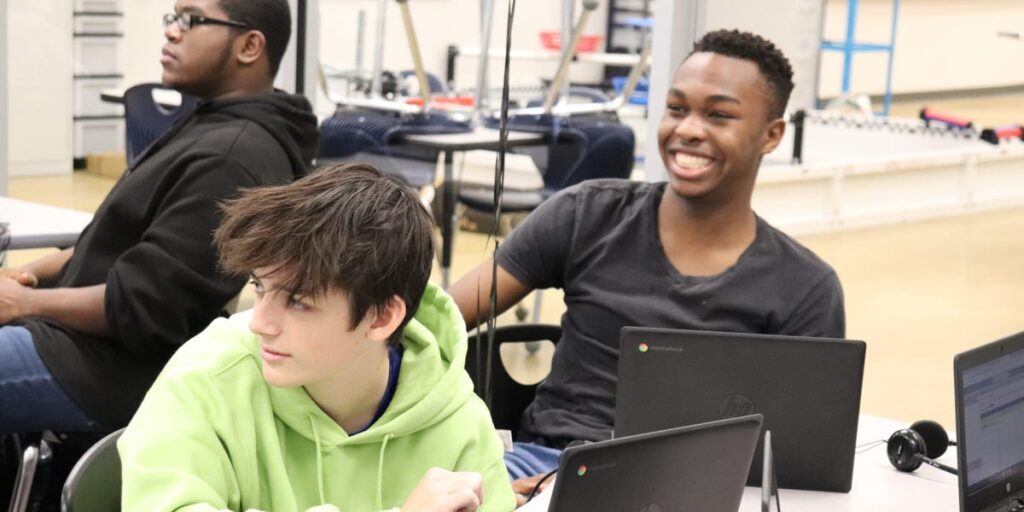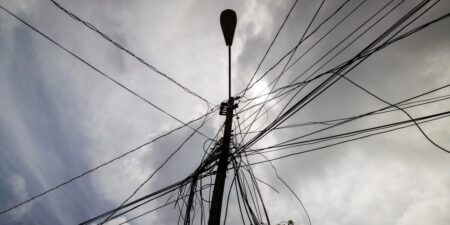- One Georgia high school has gone all-in on artificial intelligence.
- Students at Seckinger High School learn math, science, English, and history through an AI lens.
- Teachers say students are more engaged and better prepared for the jobs of the future.
Prior to joining the faculty at Seckinger High School, art teacher Megan Fowler’s only experience with anything even resembling artificial intelligence was a single graphic design class in college.
But as her teaching career progressed, “I just felt like what I was teaching was not necessarily applicable to students’ future careers,” she told Business Insider.
Now, Fowler, who is in her 13th year of teaching, uses AI every day. Whether she’s teaching students how to use large language models like ChatGPT as an artistic thought partner, introducing kids to the ethical considerations of generative art, or spearheading AI-centered professional development content for fellow teachers, Fowler has fully submitted to the power of machine learning.
Seckinger High School, located in Gwinnett County, Georgia, opened its doors in August 2022, right as AI went big. The public school, with an enrollment of about 2,000 students, operates like any other public school in Georgia’s largest school district, with one critical distinction: Students at Seckinger learn all the standard fare — math, science, English, and social studies — via an AI-embedded educational experience.
With outside help from tech partners and community collaborators, including Google and Microsoft, as well as higher ed experts and school district leaders, Gwinnett County Public Schools created an “AI-ready” framework for Seckinger students, replete with six components ranging from technical proficiency to ethics, said Sallie Holloway, director of artificial intelligence and computer science at the district.
“Our students are making connections to their future that is not as common in other schools,” Holloway said.
Teachers and administrators at the school see it as their responsibility to prepare students for the jobs of the future, many of which will require advanced knowledge of AI, four Seckinger educators told BI.
And it’s an approach that is likely to pay off, according to education experts.
Bree Dusseault, managing director at the Center for Reinventing Education, cited an Institute for the Future statistic that approximately 85% of the jobs that will be available in 2030 don’t yet exist.
“So, how do we build a school system that is helping prepare our students for this new future?”
How it works
Seckinger staff members explain the school’s AI approach using a water-based metaphor. Students can choose to swim, snorkel, or scuba dive in the oceans of AI.
“We like to say that all of our kids are swimming in AI,” said teacher Jason Hurd, who heads the AI career and technical education pathway at Seckinger. “They are exposed to it, have access to it, see it integrated into their lessons across all content areas at school.”
Next are the snorkelers, students who want to dive a bit deeper into the tech. They might take an AI elective class or join the robotics team.
Scuba divers, meanwhile, are the students who opt to enroll in the school’s AI pathway, which immerses students to the nuanced mechanics of AI via three advanced courses. These students finish high school prepared to go into a specific field involving AI, Hurd said.
AI integration at Seckinger looks very different depending on the class, subject, and teacher.
For example, Scott Gaffney, a social studies teacher, uses AI to teach students historical problem-solving. In one instance, Gaffney presented students with an outbreak of cholera in 1854 London and asked them to use AI to map the spread via dot distribution. The students then used AI to analyze the data and pinpoint the nexus of the outbreak to a specific street, he told BI.
“Gen Z processes information way faster than previous generations,” Gaffney said. “It’s fun to present them with a challenge and task them to use AI to get the solution.”
Hurd’s AI pathway course covers everything from programming to applied reasoning to ethics.
“I tell students that some days it will feel like a math class, some days it will like a philosophy class, some days it will feel like a history class,” Hurd said.
How it’s working so far
The school, which is currently in its third year of operations, is still in pilot mode as the district waits to see what aspects of Seckinger’s AI approach are ready to scale and share across the rest of the 142-school system, Holloway said.
But the anecdotal results thus far have been overwhelmingly positive, educators said.
“Kids aren’t skipping class as much and there’s a genuine interest in how teachers are teaching this content,” Holloway said. “It’s not a magic bullet, but they really are seeing an increase in engagement.”
It helps that students at Seckinger generally feel like they know why they’re learning something and how it might help them down the line, teachers said.
While there was some early community skepticism around Seckinger’s AI concept, educators said that parent attitudes have done a 180 in the last three years.
“Parents want their kids to go here, and kids want to be here,” Fowler said.
Still in its infancy, the school has yet to graduate a cohort that spent a full four years at Seckinger. Hurd, who runs the AI pathway, said he’s gotten great feedback from former students who have gone on to enroll at Georgia Tech. Similarly, Fowler said she’s seen some students go on to study digital art or user experience after graduating from Seckinger.
Looking to the future
Part of the fun — and challenge — for Seckinger teachers is staying up-to-date with the rapidly evolving technology. When the district first began discussing the idea behind Seckinger in 2019, ChatGPT had yet to be released. Today, it has over 180 million users.
“Algebra has always been algebra and will be forever,” Hurd said. “But the field of AI is constantly changing.
While some schools and districts are taking a hard-line approach to dealing with AI in education — banning tools like ChatGPT or Gemini from school servers — Seckinger staff are excited to see how their students can use AI to one day change the world.
“There were once things called Google and Wikipedia that people thought would ruin education,” Gaffney said. “They haven’t. They’ve actually sharpened our future leaders.”
Read the full article here
















